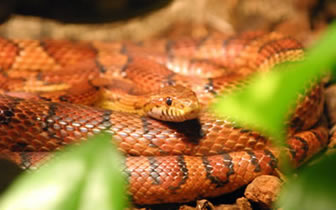Corn Snake Care

Corn snake care: Terrarium
Several important steps toward proper corn snake care can be taken long before you bring your pet home. Always prepare the terrarium well in advance and monitor the temperature using a thermometer. It is important that you adjust the temperature before you introduce the snake. The uninhabited terrarium should have kept a stable temperature for a significant period of time before you place any snake in it.
The ideal terrarium size will naturally depend on the size of your Corn snake, but a commonly adhered to rule of thumb when it comes to corn snake care states that the terrarium should be at least 20 gallons for one Corn snake. The terrarium must be covered to prevent the Corn snake from escaping.
The basic components of a Corn snake terrarium are substrate, at least 2-3 hiding spots, a heater and a water dish. The hiding spots - commonly referred to as “hides” - can for instance consist of simple cardboard boxes. If you find cardboard boxes ugly, you can go for more natural hides such as hides made from logs or rock. One hide should be located at the warmest spot of the terrarium, while the other one is placed in the coolest part of the snakes’ home. A third hide that is kept humid is also recommended as a part of the corn snake care, since the humidity will aid during shedding.
Corn snake care: Temperature
The Corn snake is a cold blooded animal and obtaining an appropriate surrounding temperature is an extremely important part of corn snake care. Improper temperatures can for instance prevent the corn snake from properly digesting its food, and this will cause illness and possibly death.
The warmest part of the terrarium should have an ambient temperature in the 80-85 degrees F range. You can use a simple light bulb to heat a small terrarium, but it is very important to guard the light bulb to avoid the snake from burning itself on it. Other ways of heating terrariums are ceramic heaters and undertank mat heaters. Never use hot rocks in the terrarium since they can become to hot and burn the snake.
Even if your heating devices are regulated by thermostats (which is highly recommended) you should use two independent thermometers as well. Place one at each end of the terrarium and make sure that it will be easy for you to check the temperature from outside the terrarium.
Corn snake care: Cleaning
Corn snake care involves cleaning the corn snake terrarium on a regular basis. Faecal matter should be removed as soon as possible, and this is true for pieces of discarded skin as well. Do not forget to check inside the hides. Once a month you should perform a more thorough cleaning where all the substrate/bedding is replaced. All items inside the terrarium, and the tank itself, should be cleaning using a mild bleach solution. Bleach will prevent parasites etcetera from thriving in the terrarium. When you have purchased a new Corn snake, it is advisable to collect its first faeces and bring them to a specialised reptile veterinarian. The vet can check the faeces for parasites, protozoan and malevolent bacteria and if necessary start treating your Corn snake before it develops signs of illness.
Corn Snake articles:
Albino Corn Snake
